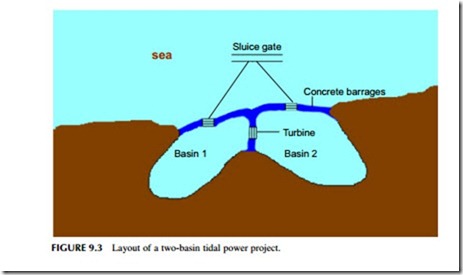TWO-BASIN PROJECTS
A conventional one-basin tidal barrage project can only generate power during a part of each tidal cycle. To get around this a variety of two-basin projects have been proposed. This adds complexity but allows either continuous generation or generation for a longer period than a single-basin design.
One type of two-basin design comprises two single basins, each with its own barrage controlling the flow of seawater in and out (Figure 9.3). These two basins are then connected by a channel into which turbines are fitted. In oper- ation, one of the basins opens its sluice gates only close to low tide, keeping the water level within its lagoon as low as possible. Meanwhile, the second opens its sluice gates toward high tide so that the water level within its lagoon is always high.
Water is then allowed to flow from one lagoon to the other through the channel linking the two. The flow rate and the capacity of the turbine within the channel is sized so that there is always more water in the high-water lagoon than in the low-water lagoon so that there will always be a head of water to drive the turbine.
The best developed project of this type was one proposed for construction near Derby in Western Australia. The project involved building barrages across two adjacent inlets and creating an artificial channel connecting the two basins formed by these barrages. A power station with turbines capable of generating 48 MW was to be stationed on this artificial channel. However, the project was never built.
An alternative two-basin scheme design has a primary reservoir that acts like a normal ebb-flow tidal plant, generating power on the ebb tide. However, on the seaward side of the primary basin is a second smaller basin. During the generation phase of the main basin, some power is used to pump water into the second basin, creating a storage basin from which power will always be available for generation whatever the state of the tide. The economics of such a scheme are relatively low at around 30% cycle energy efficiency.
